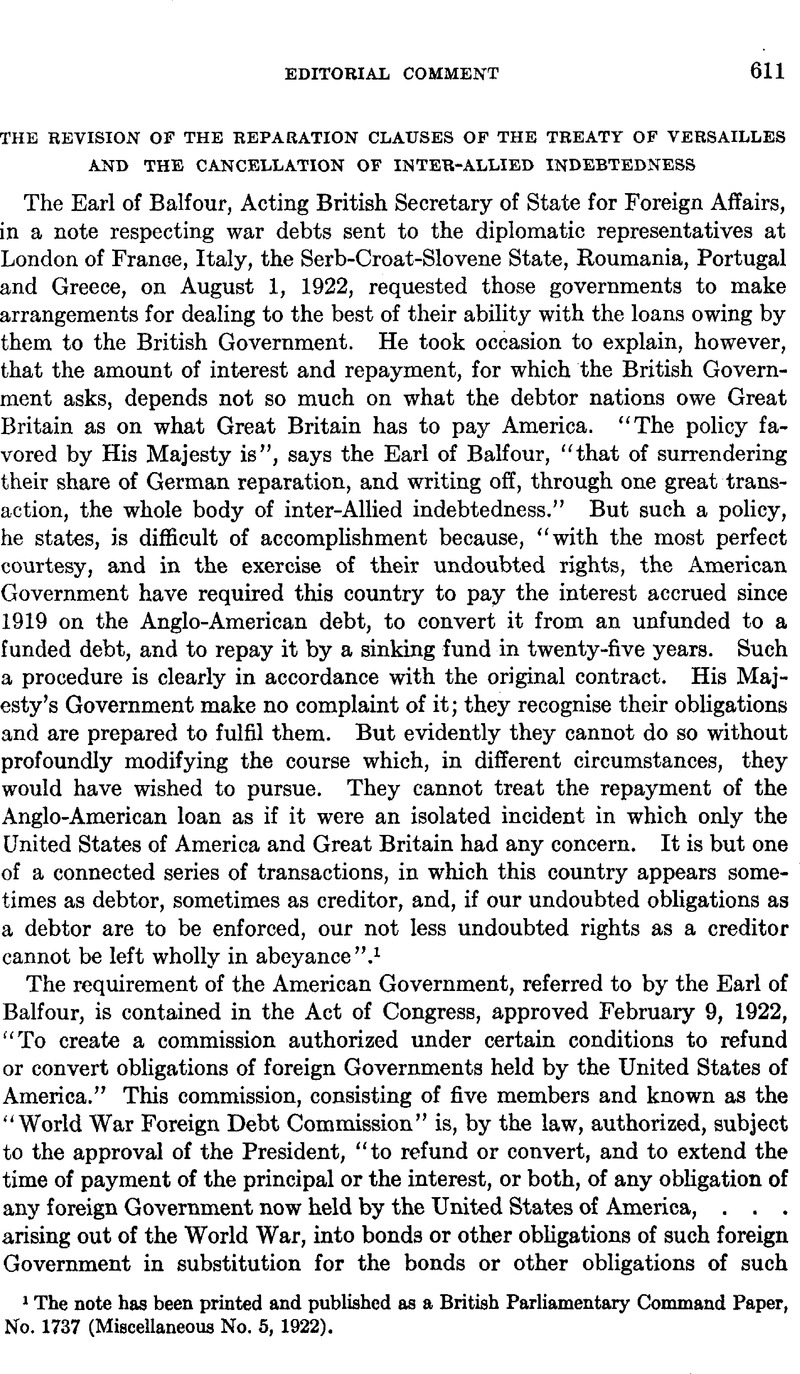No CrossRef data available.
Published online by Cambridge University Press: 04 May 2017

1 The note has been printed and published as a British Parliamentary Command Paper,No. 1737 (Miscellaneous No. 5, 1922).
2 Public No. 139, 67th Congress.
3 The Making of the Reparation and Economic Sections of the Treaty, New York: Harper and Brothers, 1920, p. 52.
4 Ibid., p. 67.
5 The Making of the Reparation and Economic Sections of the Treaty, pp. 67-68.
6 Ibid.,pp. 68-69.
7 In this connection see the article on “Reparations”byMr.Lamont, Thomas W. Google Scholar, one of the American financial representatives at the Peace Conference, in the volume entitled What really happened at Paris, New York, Charles Scribners Sons, 1921. In discussing “The Power of Clemenceau and Lloyd George”, Mr. Lamont says: “ It sounds absolutely unwarranted for me to place my opinion against those of two chiefs of state like Clemenceau and Lloyd George; yet I am convinced, as I was at the time, that they were wrong, that they entirely misread their own constituencies when they believed that if they adopted the business course of fixing the German indemnity and proceeding to collect it they would, because of the disappointment of their voters, be turned out of office. . . . All I feel is, if at this critical juncture both M. Clemenceau and Mr. Lloyd George had had a little more confidence in their own strength they would have joined with President Wilson and settled this question of German indemnity once for all, thus avoiding,to a considerable measure, the terrible consequences of continued unsettlement that have plagued Europe and the whole world since the Peace Conference adjourned and left the German indemnity question open.”(pp. 265, 268).
8 The Making of the Reparation and Economic Sections of the Treaty, p. 52.
9 The Making of the Reparation and Economic Sections of the Treaty, pp. 53, 55, 71.
10 Ibid., pp. 71-72.
11 The Truth about the Treaty, Indianapolis, the Bobbs-Merrill Co., 1921, p. 336.
12 Tardieu, The Truth about the Treaty, p. 340.
13 Translation of an article appearing in L'Illustration of October 20, 1920, quoted in Senate Document, No. 86, 67th Cong., 2d seas. p. 264.
14 Ibid., p. 264; Tardieu, ibid., p. 341
15 Senate Document No. 86, 67th Cong., 2d sess., pp. 63 and 65.
16 Congressional Record, July 18, 1921, Vol. 61, Part 4, p. 3951.
17 Senate Document No. 86, 67th Cong., 2d sess., p. 83.
18 Congressional Record, July 18, 1921, Vol. 61, Part 4, pp. 3951-52.
19 See the agreement made with Belgium on June 16, 1919 by the British and French Premiers and President Wilson, in which they undertake to recommend to their respective governmental agencies the acceptance of German reparation bonds in satisfaction of the sums borrowed by Belgium from the Allied Governments, printed in the SUPPLEMENT to this JOUENAL, p. 190.
20 Memorandum to the President, February 21, 1920, printed in Senate Document No.86, 67th Cong. 2d sees., p. 77.
21 Congressional Record, September 13, 1922, Vol. 62, No. 231, p. 13539.
22 40 U. S. Statutes at Large, p. 1312.
23 See Section 3 of the First Liberty Loan Act, April 24,1917, 40 U. S. Statutes at Large,p. 35; Section 3, Second Liberty Loan Act, September 24,1917, ibid., p. 288; and Section 7,Victory Liberty Loan Act, ibid., p. 1312.
24 Annual Report of the Secretary of the Treasury, 1920, p. 114.
25 A paper read at a dinner of the Council of Foreign Relations in New York City,February 8, 1921 by Dr. C. E. McGuire.